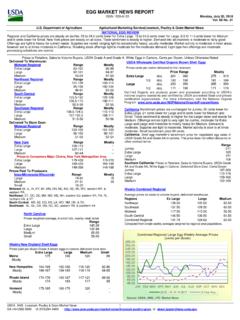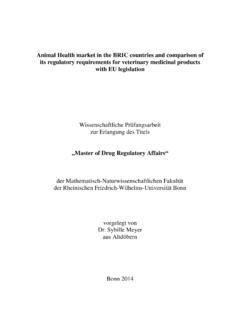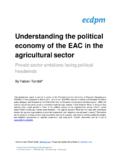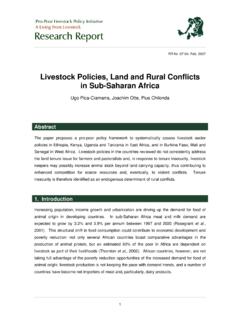Transcription of BUSINESS AND LIVELIHOODS IN AFRICAN LIVESTOCK
1 BUSINESS AND LIVELIHOODS . IN AFRICAN LIVESTOCK . Investments to overcome information gaps FEBRUARY 2014. FAO/Carl de Souza This document is an output of the LIVESTOCK Data Innovation in Africa Project, an initiative sponsored by the Bill & Melinda Gates Foundation (BMGF) and jointly implemented by the World Bank (WB), the Food and Agriculture Organization of the United Nations (FAO), the International LIVESTOCK Research Institute (ILRI) and the AFRICAN Union-Interafrican Bureau for Animal Resources (AU-IBAR) in collaboration with the governments of Niger, Tanzania and Uganda. It was prepared by a core team com- posed of Ugo Pica-Ciamarra (team leader, FAO, Rome), Derek Baker (University of New England BUSINESS School, Armidale, and formerly at ILRI, Nairobi), Nancy Morgan (FAO, Tunis), Cheick Ly (FAO, Accra), and Simplice Nouala (AU-IBAR, Nairobi).
2 The au- thors thank Gero Carletto and Alberto Zezza (World Bank), Ibrahim Gashash Ahmed (AU-IBAR), Mimako Kabayashi (World Bank), Fran ois Le Gall (World Bank), John McIntire (ILRI), Vincent Ngendakumana (AfDB), Longin Nsiima (Ministry of LIVESTOCK and Fisheries Development, Tanzania), Patrick Okello (Uganda Bureau of Statistics), Antonio Rota (IFAD), Joseph Sserugga (Ministry of Agriculture, Animal Industry and Fisheries, Uganda), Henning Steinfeld (FAO) and Windy Wilkins (BMGF) for providing valuable and constructive comments to previous versions of this document. They are also grateful to Clifton Wiens, who undertook the editing, and to Anne C. Kerns and Cristiana Giovannini for designing the layout and formatting the document. Special thanks go to Beatrice Spadacini, the Project's communication consultant, for her continual guidance.
3 The findings, interpretations and con- clusions contained in this document are those of the authors and do not necessarily reflect positions or policies of the Bill & Melinda Gates Foundation, the Food and Agriculture Organization of the United Nations, the World Bank, the International LIVESTOCK Research Institute and the AFRICAN Union-Interafrican Bureau for Animal Resources. EXECUTIVE SUMMARY Policies and investments aimed P. overty is widespread in Africa, but the continent is fast growing, with the consumption of animal protein skyrocketing, in particular for relatively at enhancing low-value, low-processed LIVESTOCK products. Meanwhile, in rural areas, the contribution the majority of households are LIVESTOCK keepers, many of whom are poor. This growth in demand for animal protein can provide major BUSINESS opportunities of LIVESTOCK to for LIVESTOCK producers, with implications for poverty reduction.
4 Economic growth and While there is heterogeneity among LIVESTOCK keepers, clustering them into poverty reduction homogenous groups is useful to guide policy and investment decisions that should target both stimulate a market-driven and inclusive growth of the sector. A small share of livelihood- oriented LIVESTOCK keepers, from between 5 to 20 percent, depending on the country, can be considered BUSINESS -oriented with incentives to expand their LIVESTOCK pro- and BUSINESS -oriented duction and tap into the growing market for animal protein. These keep relative LIVESTOCK keepers.. large herds and derive a significant share of their cash income from accessing and utilizing LIVESTOCK markets. The remainder of LIVESTOCK keepers can be defined as livelihood-oriented: they keep animals more for the many LIVELIHOODS services they provide such as insurance, manure and hauling services than for selling meat, milk and other LIVESTOCK products to the market.
5 The reason is simple: on average, they keep Tropical LIVESTOCK Units (TLUs), which is equivalent to about three beef cattle per household or about TLU per house- hold member, and, therefore, they cannot derive large benefits from regularly selling their surplus production to the market. FAO/Issouf Sanogo Policies and investments aimed at enhancing the contribution of live- stock to economic growth and poverty reduction should consequently adopt a dual strategy of targeting liveli- hood-oriented and BUSINESS -oriented LIVESTOCK keepers, who have diverse incentives to keep animals. There are, however, major information gaps which constrain the formulation of effective policy and investment decisions. First, basic information on liveli- hood-oriented LIVESTOCK keepers is typically unavailable at the national level, largely because LIVESTOCK is under-represented in statistical oper- ations.
6 This information is needed not so much to understand household's 1. The information husbandry practices and production constraints, which are known to a large ex- tent, but rather to measure the contribution of LIVESTOCK to their LIVELIHOODS and, collected through hence, to understand the potential returns from LIVESTOCK investments on their surveys is essential LIVELIHOODS , and their willingness to invest in their animals. This is a key piece to design policies of information which feeds into the design of policies and investments aimed at ensuring that livelihood-oriented LIVESTOCK keepers derive maximum benefits and investments from their animals. Consequently, governments are recommended to adequately that assist BUSINESS - include LIVESTOCK in national statistical surveys. oriented LIVESTOCK Second, even when data on LIVESTOCK are collected, these are insufficient to keepers to increase the characterize BUSINESS -oriented LIVESTOCK keepers.
7 Indeed, the typical statistical system neglects small groups and, as said, BUSINESS -oriented LIVESTOCK keepers productivity of their are few in numbers. There is also heterogeneity among them, as some could be animals. dairy specializers while others are broiler producers. Thus the characterization of specific segments of BUSINESS -oriented LIVESTOCK producers, needed for policy and investment purposes, is de facto impossible with currently available data. Consequently, governments are recommended to undertake LIVESTOCK surveys specifically targeting BUSINESS -oriented LIVESTOCK keepers. The primary objective of these surveys is not to understand the incentives these households have to invest in their animals the incentives are there but to understand in detail their production practices: how many animals are kept in these systems, what are the prevailing breeding and feeding practices, etc.
8 This information is essen- tial to design policies and investments that assist BUSINESS -oriented LIVESTOCK keepers to increase the productivity of their animals. It also provides guidance to help livelihood-oriented LIVESTOCK keepers become more BUSINESS -oriented, thereby using their animals as a tool for exiting poverty. Third, available household or farm level data for both livelihood-oriented and BUSINESS -oriented LIVESTOCK keepers are insufficient to appreciate the root causes of productivity constraints and current limited access to input and output markets. For example, available data that reveal that animal diseases and access to feed are major constraints to productivity do not inform decision makers on how the prevalence of selected animal diseases can be reduced or how the use of supplemental feed can be promoted.
9 Governments are recommended to adopt supply chain approaches to reveal LIVESTOCK productivity and market access con- straints, focusing not only on farmers as is often the case but also on other actors along the supply chains, such as drug and feed producers and distributors, and traders and processors. These actors sell inputs and services to and purchase products from LIVESTOCK keepers. Information on them, therefore, would allow governments to design policies and investments that help input suppliers, traders, processors and other actors develop BUSINESS models that are inclusive of both livelihood-oriented LIVESTOCK keepers as buyers of LIVESTOCK inputs . and BUSINESS -oriented LIVESTOCK keepers as buyers of inputs and suppliers of LIVESTOCK products. This is essential for growth of LIVESTOCK , which ultimately is a private BUSINESS .
10 2. Governments, regional institutions and the international community should Poverty is a largely jointly collaborate to collect and systemize critical LIVESTOCK information to refine the proposed LIVESTOCK for LIVELIHOODS and LIVESTOCK for BUSINESS de- rural phenomenon, velopment agenda. Policies and investments need to be reviewed within this with the majority of development paradigm, thereby promoting sustainable growth of a sector which (farm) households holds much potential for pro-poor development and economic growth, and one which can play a critical role in responding to anticipated food demand in Africa. keeping LIVESTOCK .. 1. INTRODUCTION. Poverty is widespread in Africa. The proportion of people living on less than US$ per day which defines the extremely poor ranges from less than 5 percent in North AFRICAN countries to over 80 percent in some sub-Saharan economies, such as Burundi, Chad and Madagascar.















